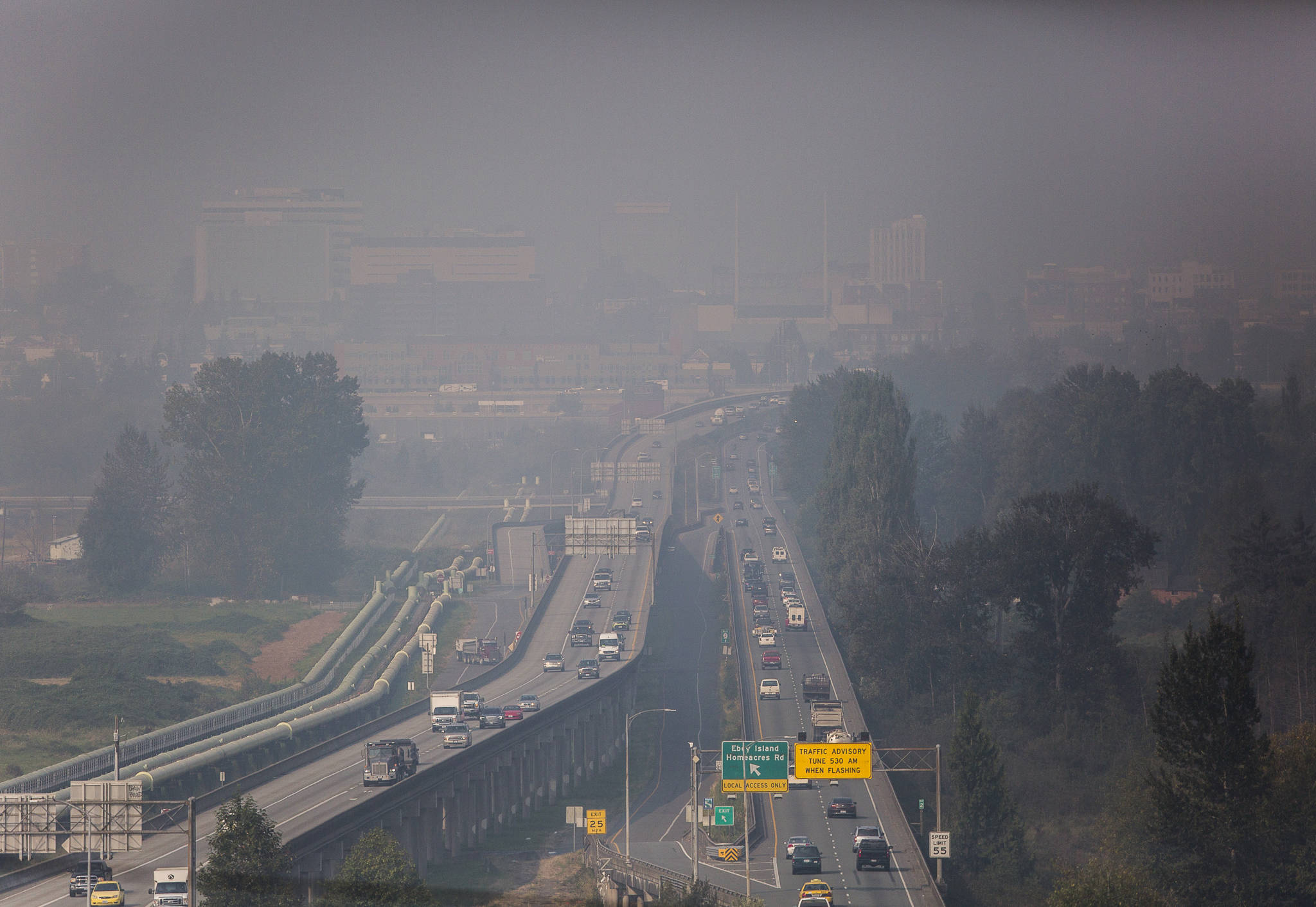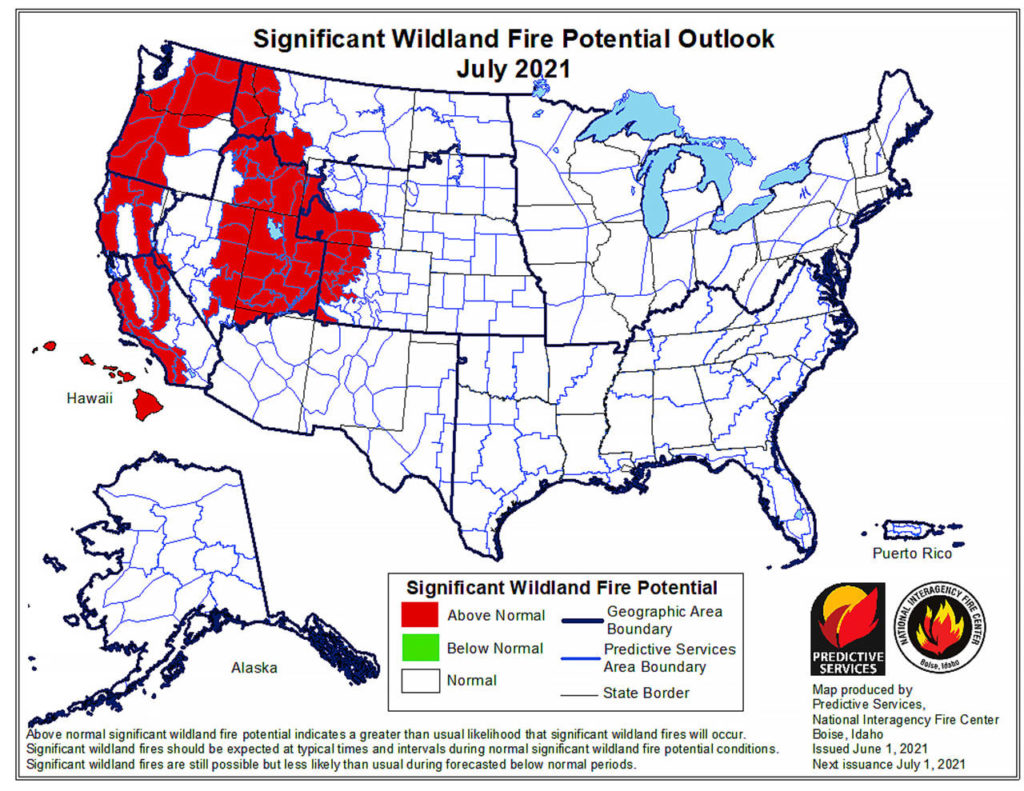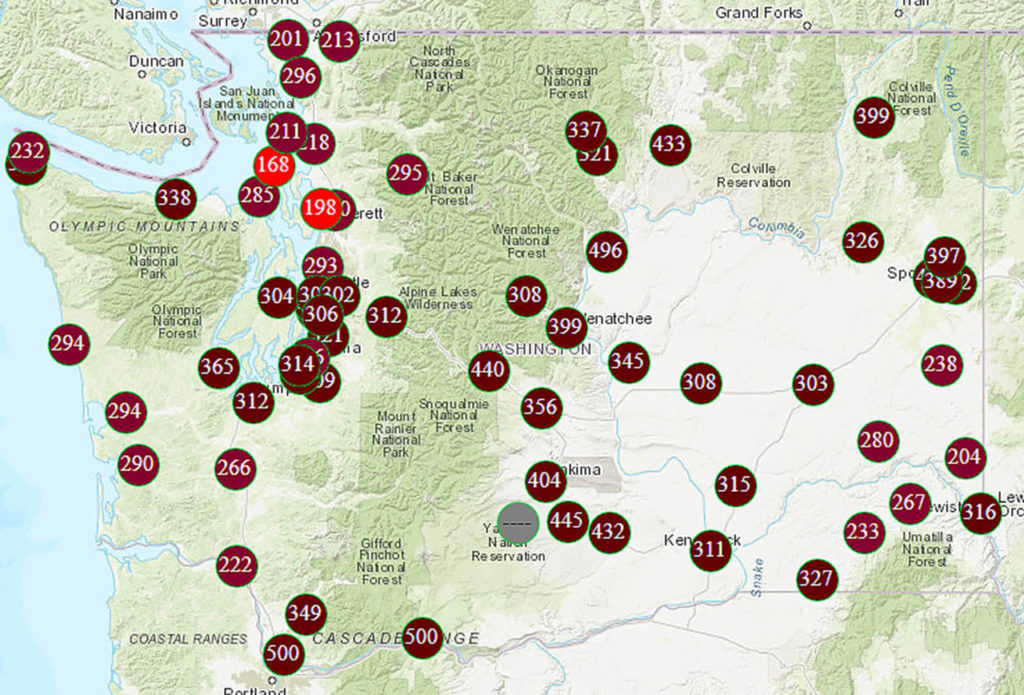EVERETT — Health experts are urging Washingtonians to prepare for more of what they suffered through last September — what the Department of Ecology called an unprecedented smoky siege. It lasted nearly two weeks. For one five-day period, every air quality monitor in the state registered unhealthy levels.
Increasing exposure to wildfire smoke, brought courtesy of climate change, is unhealthy not just for the 894,000 residents who live with asthma or chronic lung disease. And not just for children, pregnant women and the elderly, though they are also at special risk. Smoke is bad for everybody.
“There is no safe level of smoke,” said Carrie Nyssen, senior director of advocacy for the American Lung Association Washington.
An intense wildfire season is already underway in drought-stricken expanses of the West, and fire forecast maps for summer are full of angry red. The best entry point for advice and updates is the state smoke blog, wasmoke.blogspot.com. June posts include “10 tips for planning ahead.” The culprit in smoke is toxic particulate pollution known as PM2.5. Those tiny soot particles wedge into lungs and stress hearts. The result can be fatal. A 2019 University of Washington study that calculated the odds of death from forest fire smoke in the state had some surprising results.
“Our research found a slight increase in mortality risk on the same day of exposure to wildfire smoke across all populations,” said lead author Annie Doubleday. “What we didn’t expect to find was a significantly greater increase in mortality risk on the day following a wildfire smoke event for all populations, regardless of underlying health conditions or whether the air continued to be smoky that day.”
She was also surprised to find that people aged 45 to 64 years face a higher risk of dying from respiratory conditions on the day they’re exposed to smoke.
Doubleday’s research examined Washington wildfire seasons from 2006 to 2017 and found death rates increased on average by nearly 1.3% during the day after a smoke event. A later UW study looked specifically at the potential impact of the September 2020 smoke. Based on studies done elsewhere and on how much smoke was present here, lead researcher Yisi Liu estimated that roughly 92 additional deaths occurred in Washington during the 13-day event.
In the past, vehicle emissions and dust accounted for most particulate pollution. The people it hurt most lived in cities, along highways, near farms. That’s changing.
Recent wildfires accounted for a quarter of PM2.5 in the air nationwide, according to Stanford University estimates. That’s up from 10% from a decade ago, with half of the pollution in the parts of the West. A study of 18 Western cities made special note of the increase in the Pacific Northwest.
There are rarely big fires in the wet forests near Puget Sound, but the region sits at atmospheric crossroads. Last September, smoke from California and Oregon, Canada and Eastern Washington converged here.
Harm from smoke can linger long after the air quality index resets to the green “good” zone. And it can compound an existing crisis, such as a pandemic. Smoke-damaged lungs are more susceptible to COVID-19. On the plus side, the virus that has dominated life since early 2020 has caused many people to stay inside. And it has brought keen attention to indoor air quality. Ventilation systems that remove viruses will vanquish particulates, too.
When breathers become patients
Carl Hinkson, director of Pulmonary Services at Providence Regional Medical Center Everett, said respiratory therapists saw an uptick in patients because of last September’s smoke. Most suffered from existing problems and likely had inhalers and medications at home to help, he said.
Some folks struggling to breathe end up in the emergency room.
“In the hospital, there’s a lot we can do for them,” said Dr. Ryan Keay, division chief for Providence. “We have nebulizer treatments to help open airways that have spasmed up. Or we can treat them with steroids to help with the acute phase.” Patients may also be put on a breathing device similar to the CPAP machines that help some people sleep.
The Providence ER saw more patients with breathing issues during September’s smoky episode, Keay said. There was an even bigger spike the following week.
Dr. Sridar Chalaka, an Everett Clinic pulmonologist, saw a September bump in business followed by months of more people showing up with breathing problems.
“I saw patients even in January and February who were coming in for the very first time with symptoms of asthma,” he said.
What the clinic didn’t see was an increase in COVID-19 due to smoke, he said, probably because people were isolating inside. Also because of COVID precautions, he didn’t see a case of cold or flu all year.
Chalaka, who has practiced medicine in Everett for 23 years, speaks passionately of his concern about increasing smoke in the region. When air quality is poor, he is disturbed to see children at playgrounds, joggers trotting along and pets being taken for walks.
“My heart goes out to first responders. They can’t just stay home,” Chalaka said. “And the homeless — they can’t shut the doors.”
He recommends closing not only doors and windows but fireplace dampers, too. He reminds people to put their car and home air conditioning units on recycle to keep from pulling in bad air. And he wants them to forget outdoor exercise and weeding for a while. “I had patients who got outside to water their gardens for half an hour, and their breathing tests dropped by 25%,” Chalaka said.
Distant fires often lead to fiery evening skies. Chalaka doesn’t want folks lingering outside to enjoy the sunset until their eyes itch or they start to cough. “If I see a beautiful sky, I look at the air quality index.”
That good-to-hazardous index is based on information gathered at air monitoring stations, including ones in Marysville, Tulalip, Darrington and Oak Harbor. Chalaka urges people to go inside when the index reaches 50 and insists that anyone with existing health problems be indoors at 100. Any rating over 200 is unhealthy for all. In September, two Washington monitors nearest to Oregon’s wildfires topped out at the maximum of 500.
The air quality index is integrated into some weather apps. Chalaka recommends the U.S. Environmental Protection Agency’s AirNow app in the after-visit notes that he hands to patients. He started doing that in 2018 after seeing the lung damage that smoke was starting to cause. That was the same year that smoke concerns prompted so many people to check the Department of Ecology’s air quality map that the website crashed.
The summer 2018 smoke storm turned Dr. Jon Witte into a climate activist.
“It struck me that there was no place to escape,” said the retired Everett rheumatologist. “This is what climate change looks like in real life.” He witnessed the distress of his close friend, Bill, whose lung cancer flared up during that time. Bill died while waiting for his immunotherapy to begin.
Witte reconnected with Washington Physicians for Social Responsibility and joined the group’s climate change task force. He now serves on the Snohomish County Climate Advisory Committee.
Smoke information ramps up
A push to prepare the public for the 2021 fire season began June 14-18 with Smoke Ready Week. The hashtag #smokeready2021 has filled the social media streams of health and environmental agencies.
The Smoke Ready campaign was orchestrated by the Washington Department of Health, which also formed a wildfire smoke advisory group of 20-some agencies. One of the goals is to give consistent answers to questions such as: “Will the mask I’ve been wearing to fend off COVID protect me from smoke?”
The answer to that one is no, unless you have a perfectly fitted N95 mask. And even that won’t keep out noxious gases that are released when buildings burn along with forests, said state air quality specialist Kaitlyn Kelly.
A good way to keep indoor air clean is using an electronic air purifier with a HEPA filter. Portable units cost $100 to $200 and are best purchased before a smoke event, when supplies drop and prices rise. A low-cost alternative involves pairing a furnace filter with a box fan. Instructions for “DIY air filter” are easy to find, including on the websites of regional clean air agencies. The Puget Sound Clean Air Agency serves Snohomish, King and Pierce counties. Its air quality map shows almost up-to-the-minute conditions, noted air resource specialist Graeme Carvlin. Last year, many people would ask him where they could go to get out of the smoke. He had bad news.
“Wildfire smoke is generally regional,” he said. “Last September it was pretty consistent between the Olympics and the Cascades. There was a little respite at high elevations, if you wanted to go for a hike at 4,000 feet.”
Unlike smoke, information about health risks doesn’t naturally blanket the landscape. Spreading the word falls to people like Seth Preston. He is communications program manager for the Northwest Clean Air Agency, which serves Island, Skagit and Whatcom counties. He shares smoke alerts and health advice in tweets, Facebook posts, emails and the agency website. But he knows some communities don’t have good internet access, so he also reaches out through an advisory committee, health departments, community groups, fire marshals.
“They help spread the messages in their communities when things aren’t looking good,” Preston said.
The smoke got so bad in 2018 that Northwest Clean Air Agency issued its first-ever burn ban. Then, in 2020, its second. It didn’t make sense to let locals contribute to the regional smoke storm. Not everyone was eager to comply, though. One unhappy camper called Preston from Deception Pass State Park.
“He and his family were not going to be able to make s’mores over the campfire, and he asked for leniency, if you will,” Preston recalled. “That wasn’t going to happen.”
Julie Titone is an Everett writer who can be reached at julietitone@icloud.com. Her stories are supported by the Herald’s Environmental and Climate Reporting Fund.
Talk to us
> Give us your news tips.
> Send us a letter to the editor.
> More Herald contact information.



























